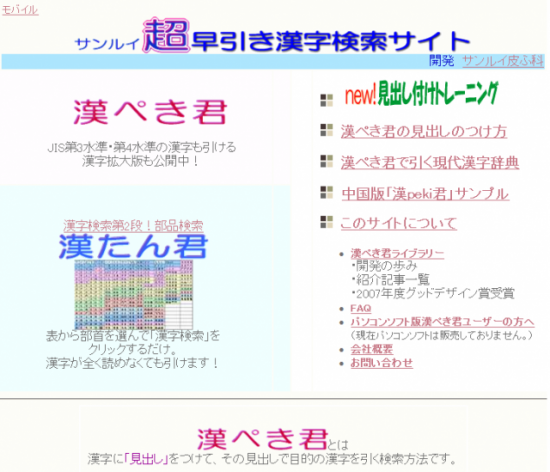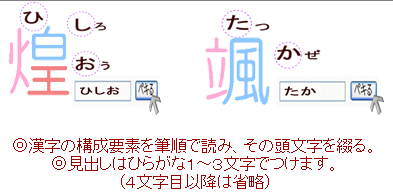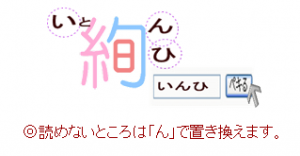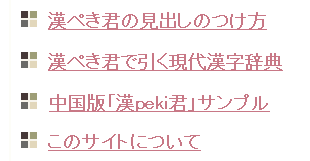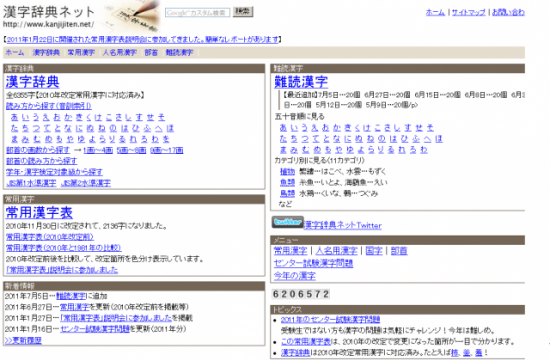Have you seen the following kanji characters before?
「蓼」「颯」
If you're seeing them for the first time, it's pretty safe to say that you probably don't know how to read them either, right?
You'd probably want to look them up using a dictionary, but how would you do that?
Um, try counting the number of strokes? Try looking them up from the radical?
Of course, you can count the stroke-number or, if there is a radical you know, you can look it up from the radical list in a dictionary.
In this article we'll introduce dictionary websites for advanced learners, where you can look up kanji via the number of strokes or the radical, plus another slightly different-to-the-norm dictionary which offers another unique way for you to look up characters.
Actually, it's a really convenient way to look difficult-to-read kanji!
漢ぺき君 Kanpeki-kun
As is written at the top of the page, '超早引き漢字検索サイト' ('Kanji-search site with a super-quick look-up function') this is a really unique system, well-suited to occasions where 1) you don't know the reading 2) you want to read a difficult kanji where you have no clue as to where to start, or 3) you are faced either with a kanji that has lots of strokes and seems really tedious to have to look up, or one where you may have seen the various parts (radicals) before but you want to search fast and not from a list of many different radicals.
With this method, you attach a '見出し' (index heading) to the kanji and use that heading to look up the character.
Let's see at what this actually means by taking a look at the website's explanation.
The kanji is '煌'.
We can see that it is made up of the 3 parts, '火', '白' and '王'.
We'll look for the initial character of the readings of each of these kanji.
火=ひ, 白=し, 王=お → "ひしお"
Enter "ひしお" into the search box, press the 'ペきる' button and you can search.
There are 3 rules for this search method.
As written in the images above (in Japanese)
・You can have up to 3 initials
・If you don't know the reading, use the 'ん' character.
And...
If you really have no clue at all, you can look the kanji up by its stroke-number.
You can also search by stroke-number, so even if you are unable to make an index-heading for the kanji you don't have to go looking for another dictionary website,
A detailed explanation of how to make an index-heading is found on the top page (under the title '漢ペき君の見出しのつけ方').
Click on '漢ぺき君', written in pink letters, and you can open up a search screen.
Once you know how to attach an index-heading to a kanji, you'll find you can look it up really quickly and easily, making this a very convenient and useful feature for advanced learners or people who are well-versed in kanji.
Those fond of difficult-to-read kanji should enjoy testing out this index-heading system to look up any characters of your choice.
Now, we'll introduce more online kanji dictionary aimed at advanced learners.
漢字辞典ネット Online Kanji Dictionary (Introduction article)
This is a website for native speakers of Japanese.
It's an online kanji dictionary covering the readings, radicals, stroke numbers, compound words and more for 6355 characters, with various ways of looking up entries.
As with most standard kanji dictionaries you can look up kanji in various ways, including 'Look up via kanji reading', 'Look up via kanji radical reading' and 'Look up via radical stroke number'.
Aside from how to read the specific kanji you've searched for, some vocabulary words which use the character are also introduced.
You can also look up difficult-to-read kanji and kanji used in people's names on this useful website.
Quick, let's look up those kanji from the beginning of the article!


